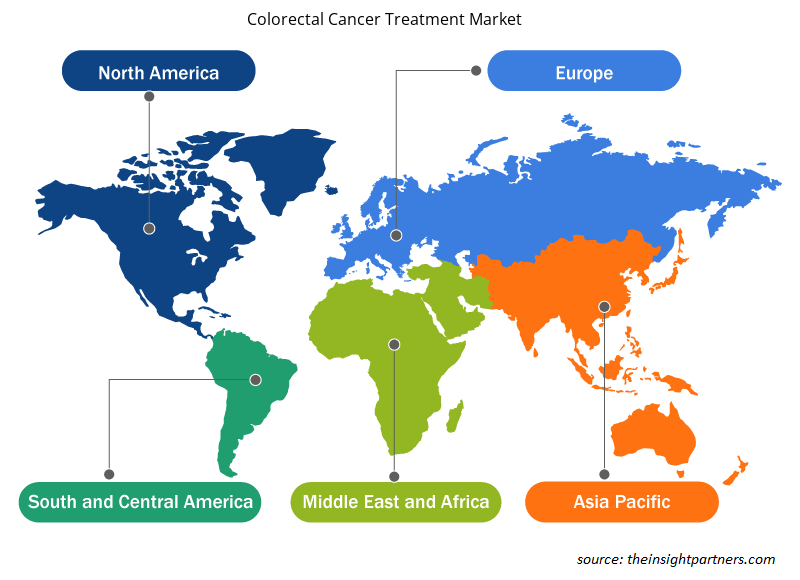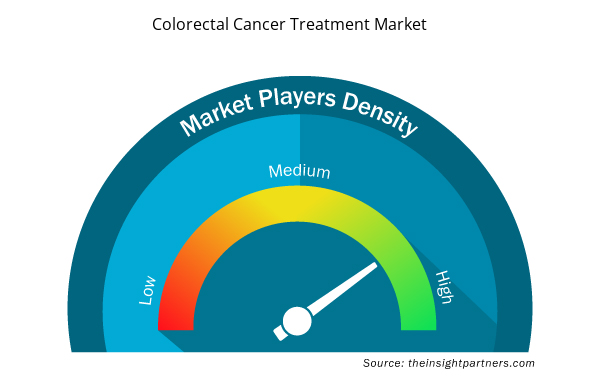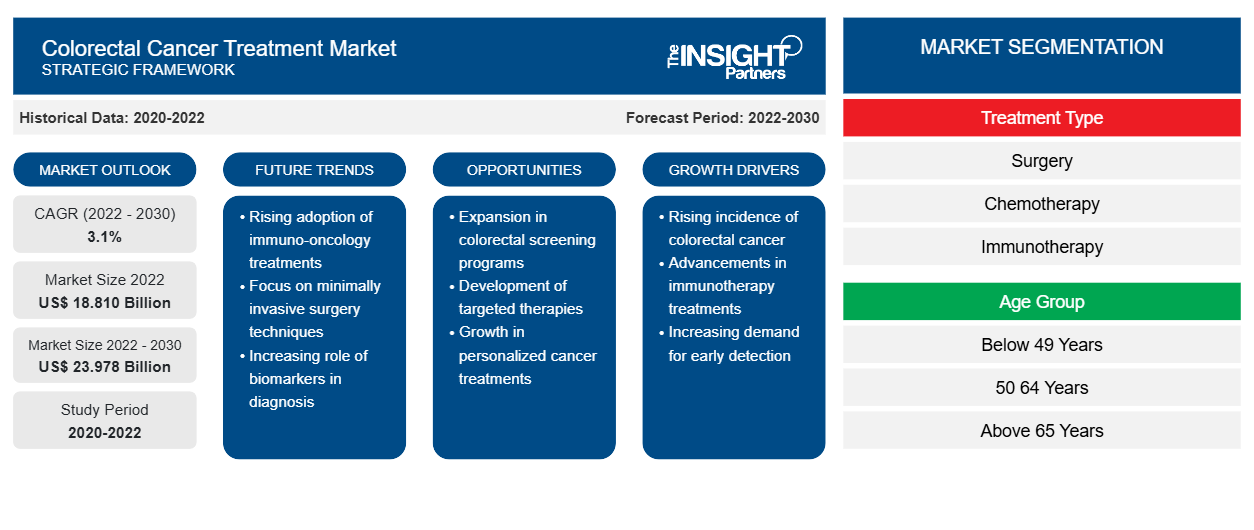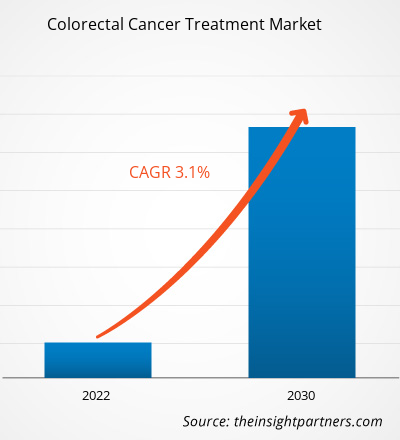[Forschungsbericht] Der Markt für die Behandlung von Dickdarmkrebs wurde im Jahr 2022 auf 18,810 Milliarden US-Dollar geschätzt und soll bis 2030 23,978 Milliarden US-Dollar erreichen. Für den Zeitraum 2022–2030 wird eine durchschnittliche jährliche Wachstumsrate von 3,1 % erwartet.
Markteinblicke und Analystenansichten:
Die wachsende Marktgröße ist auf die steigende Zahl von Fällen von Dickdarmkrebs und die zunehmende Zulassung gezielter Therapien und Immuntherapien zur Behandlung von Dickdarmkrebs zurückzuführen. Darüber hinaus treiben strategische Initiativen von Unternehmen, um auf dem Markt wettbewerbsfähig zu bleiben, das Marktwachstum an. Ein deutlicher Anstieg personalisierter Medikamente zur Deckung des Kundenbedarfs bei der Behandlung von Dickdarmkrebs dürfte im Prognosezeitraum neue Markttrends für die Behandlung von Dickdarmkrebs mit sich bringen.
Wachstumstreiber und Herausforderungen:
Darmkrebs ist ein bösartiger Tumor, der im Dickdarm- oder Mastdarmgewebe auftritt. Lebensstilfaktoren wie geringer Obst- und Gemüsekonsum, Rauchsucht, sitzende Lebensweise, Fettleibigkeit, hoher Verzehr von verarbeitetem Fleisch und übermäßiger Alkoholkonsum tragen zum Anstieg der Darmkrebsfälle bei. In den USA ist es die dritthäufigste Krebsart ( Hautkrebs ausgenommen ), die jährlich diagnostiziert wird. Im Jahr 2023 gab die Weltgesundheitsorganisation (WHO) an, dass Darmkrebs weltweit die dritthäufigste Krebsart und weltweit die zweithäufigste krebsbedingte Todesursache ist. Der gleichen Quelle zufolge sind etwa 10 % aller weltweit diagnostizierten Fälle Darmkrebs. Nach Schätzungen der American Cancer Society wurden in den USA im Jahr 2023 etwa 106.000 neue Fälle von Dickdarmkrebs und etwa 46.000 neue Fälle von Mastdarmkrebs registriert.
Laut den Daten des Europäischen Krebsinformationssystems machte Dickdarmkrebs etwa 12,7 % aller im Jahr 2020 diagnostizierten Krebserkrankungen aus, und etwa 12,4 % aller Todesfälle in den EU-27-Ländern im Jahr 2020 waren auf Dickdarmkrebs zurückzuführen. Aufgrund dieser hohen Prävalenz ist Dickdarmkrebs nach Brustkrebs die zweithäufigste Krebsart und nach Lungenkrebs die zweithäufigste krebsbedingte Todesursache. Laut der Internationalen Agentur für Krebsforschung und GLOBOCAN wurden im Jahr 2020 in Asien etwa 1 Million neue Fälle von Dickdarmkrebs gemeldet. Japan, Malaysia, China, Singapur, die Türkei und Korea verzeichneten im Vergleich zu den anderen Ländern im asiatisch-pazifischen Raum hohe Prävalenzraten. Darüber hinaus wird die weltweite Belastung durch Dickdarmkrebs bis 2040 voraussichtlich um 72 % auf über 3 Millionen Neuerkrankungen ansteigen, was eine ernsthafte Bedrohung für die menschliche Gesundheit darstellt. Die steigende Inzidenz von Dickdarmkrebs treibt also das Wachstum des Marktes für Dickdarmkrebsbehandlungen voran.
Passen Sie diesen Bericht Ihren Anforderungen an
Sie erhalten kostenlos individuelle Anpassungen an jedem Bericht, einschließlich Teilen dieses Berichts oder einer Analyse auf Länderebene, eines Excel-Datenpakets sowie tolle Angebote und Rabatte für Start-ups und Universitäten.
- Holen Sie sich die wichtigsten Markttrends aus diesem Bericht.Dieses KOSTENLOSE Beispiel umfasst eine Datenanalyse von Markttrends bis hin zu Schätzungen und Prognosen.
Berichtssegmentierung und -umfang:
Die Marktanalyse zur Behandlung von Dickdarmkrebs wurde unter Berücksichtigung der folgenden Segmente durchgeführt: Behandlungsart, Altersgruppe, Endverbraucher und Geografie. Der Markt für die Behandlung von Dickdarmkrebs ist nach Behandlungsart in Operation, Chemotherapie , zielgerichtete Therapie, Immuntherapie und andere unterteilt. Basierend auf der Altersgruppe ist der Markt in unter 49 Jahre, 50–64 Jahre und über 65 Jahre unterteilt. Der Markt ist nach Endverbraucher in Krankenhäuser, Fachkliniken, häusliche Pflege und andere unterteilt. Der Umfang des Marktberichts zur Behandlung von Dickdarmkrebs umfasst Nordamerika (USA, Kanada und Mexiko), Europa (Spanien, Großbritannien, Deutschland, Frankreich, Italien und den Rest Europas), Asien-Pazifik (Südkorea, China, Japan, Indien, Australien und den Rest des Asien-Pazifik-Raums), den Nahen Osten und Afrika (Südafrika, Saudi-Arabien, die Vereinigten Arabischen Emirate und den Rest des Nahen Ostens und Afrikas) sowie Süd- und Mittelamerika (Brasilien, Argentinien und den Rest Süd- und Mittelamerikas).
Segmentanalyse:
Der Markt für die Behandlung von Dickdarmkrebs ist nach Behandlungsart in Chirurgie, Chemotherapie, zielgerichtete Therapie, Immuntherapie und andere unterteilt. Im Jahr 2022 hatte das Segment Chirurgie den größten Marktanteil bei der Behandlung von Dickdarmkrebs und wird voraussichtlich zwischen 2022 und 2030 die höchste durchschnittliche jährliche Wachstumsrate verzeichnen. Die Operation gilt als die häufigste Behandlung für alle Stadien von Dickdarmkrebs . Wenn der Krebs im Frühstadium diagnostiziert wird, werden chirurgische Eingriffe durchgeführt, um den Tumor zu entfernen.
Basierend auf der Altersgruppe ist der Markt in unter 49 Jahre, 50–64 Jahre und über 65 Jahre segmentiert. Im Jahr 2022 hatte das Segment über 65 Jahre den größten Marktanteil bei der Behandlung von Dickdarmkrebs und wird voraussichtlich zwischen 2022 und 2030 die höchste durchschnittliche jährliche Wachstumsrate verzeichnen. Laut einem Bericht der American Cancer Society wird geschätzt, dass mehr als die Hälfte der in den USA diagnostizierten Neuerkrankungen bei über 65-Jährigen auftreten und mehr als zwei Drittel aller Todesfälle durch Dickdarmkrebs bei Personen über 65 Jahren gemeldet wurden.
Basierend auf dem Endverbraucher ist der Markt in Krankenhäuser, Fachkliniken, häusliche Pflege und andere unterteilt. Die Marktgröße der Behandlung von Dickdarmkrebs im Krankenhaussegment wird zwischen 2022 und 2030 wahrscheinlich stark ansteigen.
Regionale Analyse:
Nordamerika leistet den größten Beitrag zum weltweiten Wachstum des Marktes für die Behandlung von Dickdarmkrebs. Der asiatisch-pazifische Raum wird voraussichtlich zwischen 2022 und 2030 die höchste durchschnittliche jährliche Wachstumsrate (CAGR) auf dem Markt aufweisen. Nordamerika hatte 2022 den größten Anteil am Weltmarkt aufgrund der steigenden Zahl von Dickdarmkrebserkrankungen, des zunehmenden technologischen Fortschritts, der hohen Prävalenz von Dickdarmkrebs bei Menschen unter 50 Jahren und der Präsenz wichtiger Marktteilnehmer, die an neuen und bestehenden Produktentwicklungen beteiligt sind. In Nordamerika hatten die USA 2022 den größten Marktanteil.
Branchenentwicklungen und zukünftige Chancen:
Die Marktprognose für die Behandlung von Dickdarmkrebs wird auf der Grundlage verschiedener sekundärer und primärer Forschungsergebnisse wie wichtiger Unternehmensveröffentlichungen, Verbandsdaten und Datenbanken geschätzt. Im Folgenden sind die Strategien der wichtigsten Akteure auf dem Markt für die Behandlung von Dickdarmkrebs aufgeführt:
- Im November 2023 gab Takeda Pharmaceutical bekannt, dass es von der US-amerikanischen Food and Drug Administration (FDA) die Zulassung für seine orale zielgerichtete Therapie FRUZAQLA (Fruquintinib) zur Behandlung von Erwachsenen mit metastasiertem Dickdarmkrebs (mCRC) erhalten hat. FRUZAQLA ist der erste und einzige selektive Inhibitor aller drei VEGF-Rezeptorkinasen, der in den USA zuvor zur Behandlung von mCRC zugelassen wurde, unabhängig vom Biomarkerstatus.
- Im August 2023 gab Taiho Pharmaceutical Co., Ltd. bekannt, dass die US-amerikanische FDA LONSURF (Trifluridin/Tipiracil) als Einzelwirkstoff und in Kombination mit Bevacizumab zur Behandlung erwachsener Patienten mit mCRC zugelassen hat. Diese Patienten werden zuvor mit einer Chemotherapie auf Basis von Oxaliplatin, Fluoropyrimidin und Irinotecan behandelt, einer biologischen Anti-VEGF-Therapie.
Regionale Einblicke in den Markt für die Behandlung von Dickdarmkrebs
Die regionalen Trends und Faktoren, die den Markt für die Behandlung von Dickdarmkrebs im Prognosezeitraum beeinflussen, wurden von den Analysten von Insight Partners ausführlich erläutert. In diesem Abschnitt werden auch die Marktsegmente und die Geografie für die Behandlung von Dickdarmkrebs in Nordamerika, Europa, im asiatisch-pazifischen Raum, im Nahen Osten und Afrika sowie in Süd- und Mittelamerika erörtert.

- Erhalten Sie regionale Daten zum Markt für die Behandlung von Dickdarmkrebs
Umfang des Marktberichts zur Behandlung von Dickdarmkrebs
| Berichtsattribut | Details |
|---|---|
| Marktgröße im Jahr 2022 | 18,810 Milliarden US-Dollar |
| Marktgröße bis 2030 | 23,978 Milliarden US-Dollar |
| Globale CAGR (2022 - 2030) | 3,1 % |
| Historische Daten | 2020-2022 |
| Prognosezeitraum | 2022–2030 |
| Abgedeckte Segmente | Nach Behandlungstyp
|
| Abgedeckte Regionen und Länder | Nordamerika
|
| Marktführer und wichtige Unternehmensprofile |
|
Marktteilnehmerdichte bei der Behandlung von Dickdarmkrebs: Auswirkungen auf die Geschäftsdynamik verstehen
Der Markt für die Behandlung von Dickdarmkrebs wächst rasant, angetrieben durch die steigende Nachfrage der Endnutzer aufgrund von Faktoren wie sich entwickelnden Verbraucherpräferenzen, technologischen Fortschritten und einem größeren Bewusstsein für die Vorteile des Produkts. Mit der steigenden Nachfrage erweitern Unternehmen ihr Angebot, entwickeln Innovationen, um die Bedürfnisse der Verbraucher zu erfüllen, und nutzen neue Trends, was das Marktwachstum weiter ankurbelt.
Die Marktteilnehmerdichte bezieht sich auf die Verteilung der Firmen oder Unternehmen, die in einem bestimmten Markt oder einer bestimmten Branche tätig sind. Sie gibt an, wie viele Wettbewerber (Marktteilnehmer) in einem bestimmten Marktraum im Verhältnis zu seiner Größe oder seinem gesamten Marktwert präsent sind.
Die wichtigsten auf dem Markt für die Behandlung von Dickdarmkrebs tätigen Unternehmen sind:
- Genentech Inc
- Eli Lilly und Company
- Pfizer Inc
- Takeda Pharma
- Bristol Myers Squibb
Haftungsausschluss : Die oben aufgeführten Unternehmen sind nicht in einer bestimmten Reihenfolge aufgeführt.

- Überblick über die wichtigsten Akteure auf dem Markt für die Behandlung von Dickdarmkrebs
Wettbewerbslandschaft und Schlüsselunternehmen:
Genentech Inc, Eli Lilly and Company, Pfizer Inc, Takeda Pharmaceuticals, Bristol Myers Squibb, Merck, Bayer AG, Regeneron Pharmaceuticals Inc, Novartis AG und Ipsen Biopharmaceuticals Inc gehören zu den prominenten Akteuren, die im Marktbericht zur Behandlung von Dickdarmkrebs vorgestellt werden. Darüber hinaus wurden im Rahmen der Studie mehrere andere Akteure untersucht und analysiert, um einen ganzheitlichen Überblick über den Markt und sein Ökosystem zu erhalten. Diese Unternehmen konzentrieren sich auf geografische Expansionen und die Einführung neuer Produkte, um die wachsende Nachfrage von Verbrauchern weltweit zu befriedigen und ihre Produktpalette in Spezialportfolios zu erweitern. Ihre globale Präsenz ermöglicht es ihnen, einen großen Kundenstamm zu bedienen und so die Marktexpansion zu erleichtern.
- Historische Analyse (2 Jahre), Basisjahr, Prognose (7 Jahre) mit CAGR
- PEST- und SWOT-Analyse
- Marktgröße Wert/Volumen – Global, Regional, Land
- Branche und Wettbewerbsumfeld
- Excel-Datensatz


- Microcatheters Market
- Broth Market
- Sleep Apnea Diagnostics Market
- Long Read Sequencing Market
- Resistance Bands Market
- Data Center Cooling Market
- Nuclear Decommissioning Services Market
- Equipment Rental Software Market
- Vaginal Specula Market
- Health Economics and Outcome Research (HEOR) Services Market

Report Coverage
Revenue forecast, Company Analysis, Industry landscape, Growth factors, and Trends

Segment Covered
This text is related
to segments covered.

Regional Scope
North America, Europe, Asia Pacific, Middle East & Africa, South & Central America

Country Scope
This text is related
to country scope.
Häufig gestellte Fragen
The colorectal cancer treatment market majorly consists of the players such Genentech Inc, Eli Lilly and Company, Pfizer Inc, Takeda Pharmaceuticals, Bristol Myers Squibb, Merck, Bayer AG, Regeneron Pharmaceuticals Inc, Novartis AG, and Ipsen Biopharmaceuticals Inc.
Based on geography, the colorectal cancer treatment market is segmented into North America (the US, Canada, and Mexico), Europe (the UK, Germany, France, Italy, Spain, and the Rest of Europe), Asia Pacific (China, Japan, India, South Korea, Australia, and the Rest of Asia Pacific), the Middle East & Africa (the UAE, Saudi Arabia, South Africa, and Rest of the Middle East & Africa), and South & Central America (Brazil, Argentina, and the Rest of South & Central America). North America is the largest contributor to the growth of the global colorectal cancer treatment market. Asia Pacific is expected to register the highest CAGR in the colorectal cancer treatment market during 2022–2030.
Colorectal cancer often begins as a growth called a polyp inside the colon or rectum. Colorectal cancer happens when there are changes in genetic material (DNA). These changes are also called mutations or variants. Often, the genetic changes that lead to colorectal cancer happen during lifetime and the exact cause is unknown. Colorectal cancer treatment includes surgery, chemotherapy, radiation therapy, targeted therapy, immunotherapy, cryosurgery, and radiofrequency ablation.
The growing number of colorectal cancer cases and the subsequent increase in product launches are factors predominantly driving the colorectal cancer treatment market size. However, the high cost associated with colorectal cancer treatment in developing countries hinders the market growth.
The colorectal cancer treatment market, by treatment type, is segmented into surgery, chemotherapy, targeted therapy, immunotherapy, and others. In 2022, the surgery segment held the largest colorectal cancer treatment market share and is expected to record the highest CAGR during 2022–2030.
Based on age group, the market is segmented into below 49 years, 50–64 years, and above 65 years. In 2022, the above 65 years segment held the largest colorectal cancer treatment market share and is projected to record the highest CAGR during 2022–2030.
Based on end user, the market is divided into hospitals, specialty clinics, home care, and others. The colorectal cancer treatment market size for the hospital segment is likely to surge during 2022–2030.
Trends and growth analysis reports related to Life Sciences : READ MORE..
The List of Companies - Colorectal Cancer Treatment Market
- Genentech Inc
- Eli Lilly and Company
- Pfizer Inc
- Takeda Pharmaceuticals
- Bristol Myers Squibb
- Merck
- Bayer AG
- Regeneron Pharmaceuticals Inc
- Novartis AG
- Ipsen Biopharmaceuticals
The Insight Partners performs research in 4 major stages: Data Collection & Secondary Research, Primary Research, Data Analysis and Data Triangulation & Final Review.
- Data Collection and Secondary Research:
As a market research and consulting firm operating from a decade, we have published and advised several client across the globe. First step for any study will start with an assessment of currently available data and insights from existing reports. Further, historical and current market information is collected from Investor Presentations, Annual Reports, SEC Filings, etc., and other information related to company’s performance and market positioning are gathered from Paid Databases (Factiva, Hoovers, and Reuters) and various other publications available in public domain.
Several associations trade associates, technical forums, institutes, societies and organization are accessed to gain technical as well as market related insights through their publications such as research papers, blogs and press releases related to the studies are referred to get cues about the market. Further, white papers, journals, magazines, and other news articles published in last 3 years are scrutinized and analyzed to understand the current market trends.
- Primary Research:
The primarily interview analysis comprise of data obtained from industry participants interview and answers to survey questions gathered by in-house primary team.
For primary research, interviews are conducted with industry experts/CEOs/Marketing Managers/VPs/Subject Matter Experts from both demand and supply side to get a 360-degree view of the market. The primary team conducts several interviews based on the complexity of the markets to understand the various market trends and dynamics which makes research more credible and precise.
A typical research interview fulfils the following functions:
- Provides first-hand information on the market size, market trends, growth trends, competitive landscape, and outlook
- Validates and strengthens in-house secondary research findings
- Develops the analysis team’s expertise and market understanding
Primary research involves email interactions and telephone interviews for each market, category, segment, and sub-segment across geographies. The participants who typically take part in such a process include, but are not limited to:
- Industry participants: VPs, business development managers, market intelligence managers and national sales managers
- Outside experts: Valuation experts, research analysts and key opinion leaders specializing in the electronics and semiconductor industry.
Below is the breakup of our primary respondents by company, designation, and region:

Once we receive the confirmation from primary research sources or primary respondents, we finalize the base year market estimation and forecast the data as per the macroeconomic and microeconomic factors assessed during data collection.
- Data Analysis:
Once data is validated through both secondary as well as primary respondents, we finalize the market estimations by hypothesis formulation and factor analysis at regional and country level.
- Macro-Economic Factor Analysis:
We analyse macroeconomic indicators such the gross domestic product (GDP), increase in the demand for goods and services across industries, technological advancement, regional economic growth, governmental policies, the influence of COVID-19, PEST analysis, and other aspects. This analysis aids in setting benchmarks for various nations/regions and approximating market splits. Additionally, the general trend of the aforementioned components aid in determining the market's development possibilities.
- Country Level Data:
Various factors that are especially aligned to the country are taken into account to determine the market size for a certain area and country, including the presence of vendors, such as headquarters and offices, the country's GDP, demand patterns, and industry growth. To comprehend the market dynamics for the nation, a number of growth variables, inhibitors, application areas, and current market trends are researched. The aforementioned elements aid in determining the country's overall market's growth potential.
- Company Profile:
The “Table of Contents” is formulated by listing and analyzing more than 25 - 30 companies operating in the market ecosystem across geographies. However, we profile only 10 companies as a standard practice in our syndicate reports. These 10 companies comprise leading, emerging, and regional players. Nonetheless, our analysis is not restricted to the 10 listed companies, we also analyze other companies present in the market to develop a holistic view and understand the prevailing trends. The “Company Profiles” section in the report covers key facts, business description, products & services, financial information, SWOT analysis, and key developments. The financial information presented is extracted from the annual reports and official documents of the publicly listed companies. Upon collecting the information for the sections of respective companies, we verify them via various primary sources and then compile the data in respective company profiles. The company level information helps us in deriving the base number as well as in forecasting the market size.
- Developing Base Number:
Aggregation of sales statistics (2020-2022) and macro-economic factor, and other secondary and primary research insights are utilized to arrive at base number and related market shares for 2022. The data gaps are identified in this step and relevant market data is analyzed, collected from paid primary interviews or databases. On finalizing the base year market size, forecasts are developed on the basis of macro-economic, industry and market growth factors and company level analysis.
- Data Triangulation and Final Review:
The market findings and base year market size calculations are validated from supply as well as demand side. Demand side validations are based on macro-economic factor analysis and benchmarks for respective regions and countries. In case of supply side validations, revenues of major companies are estimated (in case not available) based on industry benchmark, approximate number of employees, product portfolio, and primary interviews revenues are gathered. Further revenue from target product/service segment is assessed to avoid overshooting of market statistics. In case of heavy deviations between supply and demand side values, all thes steps are repeated to achieve synchronization.
We follow an iterative model, wherein we share our research findings with Subject Matter Experts (SME’s) and Key Opinion Leaders (KOLs) until consensus view of the market is not formulated – this model negates any drastic deviation in the opinions of experts. Only validated and universally acceptable research findings are quoted in our reports.
We have important check points that we use to validate our research findings – which we call – data triangulation, where we validate the information, we generate from secondary sources with primary interviews and then we re-validate with our internal data bases and Subject matter experts. This comprehensive model enables us to deliver high quality, reliable data in shortest possible time.


 Holen Sie sich ein kostenloses Muster für diesen Bericht
Holen Sie sich ein kostenloses Muster für diesen Bericht